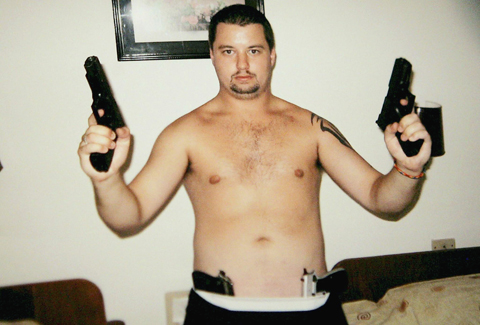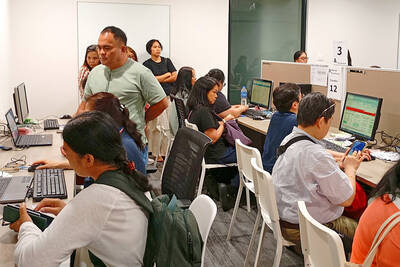Airlifted in from Bolivia’s western highlands, some two dozen elite officers in green helmets and flak jackets entered the Las Americas Hotel just before 4am, disabled its surveillance cameras and stealthily made for the fourth floor.
A bomb exploded. After 15 minutes of gunfire, three men were dead in their underwear on separate hotel room floors: A Bolivian-born Hungarian, an Irishman and a Romanian. Two of their comrades with ties to Croatia and Hungary were arrested in rooms down the hall.
A few hours later, Bolivian President Evo Morales announced during a visit to Venezuela that an assassination plot against him, hatched by right-wing extremists and employing foreign mercenaries, had been foiled on his instructions.

PHOTO: EPA
“Before I left,” he said, “I gave the order.”
The strange events of April 16 have only deepened political and social rifts in this nation of 10 million, where Morales, an Indian and a strident leftist, faces an intransigent foe in the light-skinned elite of this provincial capital.
Bolivian Vice President Alvaro Garcia has blamed the alleged plot on “the fascist and racist right” of Santa Cruz.
Morales’ opponents in turn claim the government is trying to discredit them and bolster his campaign for re-election in December.
Hungary, Ireland, Romania and Croatia have all asked for what the latter called “a full and impartial” accounting. Was it not possible to wait a few hours and capture the alleged conspirators peacefully at breakfast?
“The Irish government has a legitimate right to seek the facts of how one of its citizens came to be killed by the security forces of another state,” Irish Foreign Minister Michael Martin said.
Yet more than two weeks after the raid, Bolivia has yet to provide details of the alleged conspiracy. It’s a puzzle, in the words of Hungarian Foreign Minister Peter Balazs, in which the pieces don’t fit.
An indignant Morales at first resisted the calls for explanation.
Then, at the UN on April 22, he said he was willing to accept an international investigation.
WARRIOR CREDENTIALS
Such a probe would almost certainly begin with Eduardo Rozsa Flores, the only one of the slain men with clear warrior credentials.
In September, he told a TV journalist in Hungary that he was returning home to organize a militia. You can only broadcast the interview, Rozsa said, if I don’t return alive.
Born in Santa Cruz 49 years ago to a Hungarian father and Bolivian mother, Rozsa boasted in interviews and in a blog of serving as a translator for “Carlos the Jackal” when the Venezuelan terrorist was living in then-communist Hungary.
After the Berlin Wall fell, Rozsa became a minor celebrity in Croatia for commanding a brigade of foreign volunteers in its 1991 independence war. A poet, journalist and recent convert to Islam, he later starred as himself in Chico, a biopic that won best film in Hungary’s national cinema festival in 2002.
The other two slain men apparently lacked Rozsa’s combat experience, if not his sense of adventure. So under what premise — and for what exactly — did he recruit them? Michael Dwyer was a 24-year-old Irish security guard whose family said he went to Bolivia in October looking for work. His Facebook pages show he liked to play Airsoft, a game similar to paintball.
Arpad Magyarosi, 29, was an ethnic Hungarian rock musician and schoolteacher from Romania who relatives said loved to travel.
The raid’s two survivors were flown to the highlands capital of La Paz and jailed without bail on terrorism charges after a closed hearing. They are Mario Tadic, a 51-year-old Bolivian-Croat comrade-in-arms of Rozsa from the Balkans, and Hungarian computer technician Elod Toaso.
Bolivian Defense Minister Walker San Miguel said Rozsa recruited Toaso, 28, through the Szekler Legion, a right-wing group that promotes autonomy for Romania’s ethnic Hungarians. Hungary’s ambassador, Matyas Jozsa, told reporters after visiting Toaso in jail that the former bank employee may not have understood what he was getting into.
He believes the slain men never had a chance to surrender and said Toaso saved himself by diving face-down to the floor and putting his hands on the back of his neck.
How Tadic survived is unclear.
The hotel’s manager, Hernan Rossell, told reporters he arrived on the scene 10 minutes after the shooting ended and saw Rozsa’s body on the floor, a revolver about 40cm from his right hand and a bullet wound in his face. It was the only weapon Rossell said he saw on the fourth floor not wielded by the police, none of whom were injured in the raid.
Julio Larrea, a police investigator, said the alleged mercenaries set off a C4 plastic explosives charge just before the shootout began. He said police recovered guns at the scene, though he didn’t specify how many or where, except that a handgun and a silencer were found in Rozsa’s room.
Authorities have offered no evidence that the slain men fired weapons. An autopsy done on Dwyer’s badly decomposed body in Ireland determined he was killed by a single gunshot to the chest, but apparently little more.
Many aspects of the case are still a mystery.
POSERS
On the day of the raid, Bolivian police confiscated about a dozen weapons at a convention center booth that they said the alleged assassins had rented through a local telecommunications company or a business fair. Prosecutor Marcelo Sosa later showed photos he said were found at the convention center booth of all the alleged mercenaries (not including Tadic) posing with guns. In one, Dwyer has a pistol in each hand.
Police also said the men were responsible for a dynamite blast the day before at the home of the local Roman Catholic cardinal in which nobody was hurt and minor damage incurred. They presented another man, Juan Carlos Gueder, who has been arrested on terrorism charges. Gueder told reporters he sold Rozsa a pistol and that Rozsa said he planned to assassinate Santa Cruz Governor Ruben Costas to make him “a martyr.”
Vice President Garcia said the alleged mercenaries were planning to kill him and Morales, then “organize civilian groups for an armed resistance to violently seize power.”
The evidence authorities have provided to date is a three-minute video that Sosa says was obtained from an informant. He says it shows the three slain men lamenting missing a chance to bomb a boat on which Morales held a Cabinet meeting in Lake Titicaca early last month.
The accompanying audio is unclear, however. Reporters who viewed it could make out words including “Titicaca,” “wetsuit” and “explosives” but no clear narrative.

Kehinde Sanni spends his days smoothing out dents and repainting scratched bumpers in a modest autobody shop in Lagos. He has never left Nigeria, yet he speaks glowingly of Burkina Faso military leader Ibrahim Traore. “Nigeria needs someone like Ibrahim Traore of Burkina Faso. He is doing well for his country,” Sanni said. His admiration is shaped by a steady stream of viral videos, memes and social media posts — many misleading or outright false — portraying Traore as a fearless reformer who defied Western powers and reclaimed his country’s dignity. The Burkinabe strongman swept into power following a coup in September 2022

‘FRAGMENTING’: British politics have for a long time been dominated by the Labor Party and the Tories, but polls suggest that Reform now poses a significant challenge Hard-right upstarts Reform UK snatched a parliamentary seat from British Prime Minister Keir Starmer’s Labor Party yesterday in local elections that dealt a blow to the UK’s two establishment parties. Reform, led by anti-immigrant firebrand Nigel Farage, won the by-election in Runcorn and Helsby in northwest England by just six votes, as it picked up gains in other localities, including one mayoralty. The group’s strong showing continues momentum it built up at last year’s general election and appears to confirm a trend that the UK is entering an era of multi-party politics. “For the movement, for the party it’s a very, very big

A new online voting system aimed at boosting turnout among the Philippines’ millions of overseas workers ahead of Monday’s mid-term elections has been marked by confusion and fears of disenfranchisement. Thousands of overseas Filipino workers have already cast their ballots in the race dominated by a bitter feud between President Ferdinand Marcos Jr and his impeached vice president, Sara Duterte. While official turnout figures are not yet publicly available, data from the Philippine Commission on Elections (COMELEC) showed that at least 134,000 of the 1.22 million registered overseas voters have signed up for the new online system, which opened on April 13. However,

ENTERTAINMENT: Rio officials have a history of organizing massive concerts on Copacabana Beach, with Madonna’s show drawing about 1.6 million fans last year Lady Gaga on Saturday night gave a free concert in front of 2 million fans who poured onto Copacabana Beach in Rio de Janeiro for the biggest show of her career. “Tonight, we’re making history... Thank you for making history with me,” Lady Gaga told a screaming crowd. The Mother Monster, as she is known, started the show at about 10:10pm local time with her 2011 song Bloody Mary. Cries of joy rose from the tightly packed fans who sang and danced shoulder-to-shoulder on the vast stretch of sand. Concert organizers said 2.1 million people attended the show. Lady Gaga